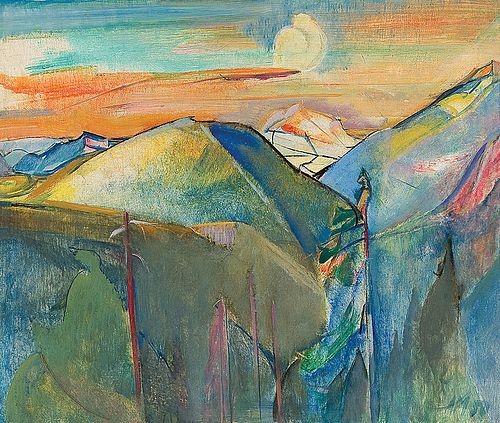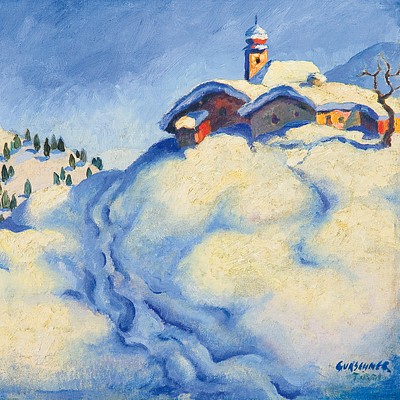ANTON MAHRINGER* (Neuhausen auf den Fildern 1902 - 1974 Villach)
Lot 151
Estimate:
EUR€25,000 - EUR€35,000
$26,881.72 - $37,634.41
Absentee vs Live bid
Two ways to bid:
- Leave a max absentee bid and the platform will bid on your behalf up to your maximum bid during the live auction.
- Bid live during the auction and your bids will be submitted real-time to the auctioneer.
Bid Increments
| Price | Bid Increment |
|---|---|
| EUR€0 | EUR€10 |
| EUR€100 | EUR€50 |
| EUR€700 | EUR€100 |
| EUR€1,000 | EUR€200 |
| EUR€3,000 | EUR€300 |
| EUR€3,600 | EUR€400 |
| EUR€4,000 | EUR€500 |
| EUR€7,000 | EUR€1,000 |
| EUR€16,000 | EUR€2,000 |
| EUR€30,000 | EUR€3,000 |
| EUR€36,000 | EUR€4,000 |
| EUR€40,000 | EUR€5,000 |
| EUR€150,000 | EUR€10,000 |
About Auction
By Widder Auctions
Nov 23, 2023
Set Reminder
2023-11-23 11:00:00
2023-11-23 11:00:00
America/New_York
Bidsquare
Bidsquare : Masterpieces
https://www.bidsquare.com/auctions/widder-auctions/masterpieces-14076
Masterpieces by Austrian and German artists are coming up for auction in Vienna on November 23rd Widder Auctions office@widderauktionen.com
Masterpieces by Austrian and German artists are coming up for auction in Vienna on November 23rd Widder Auctions office@widderauktionen.com
- Lot Description
ANTON MAHRINGER* (Neuhausen auf den Fildern 1902 - 1974 Villach)
Mountainscape with sun set, 1950
oil/canvas, 55,3 x 66 cm
monogrammed AM, dated 50
verso signed, dated and inscribed Anton Mahringer, St. Georgen/Gailtal 1950, Kesselwaldlandschaft mit Sonnenuntergang (Kessel forrest landscape with sun set)
depicted in catalogue raisonné Mahringer, p. 314 No. 471
ESTIMATE € 25000 - 35000
STARTING PRICE € 25000
The German-Austrian painter Anton Mahringer is particularly known for his landscape watercolors. Alongside Sebastian Isepp, Anton Kolig and Franz Wiegele, Mahringer is part of the Nötscher circle. He gained his first artistic experiences in painting courses at the goldsmiths' college in Schwäbisch Gmünd. In 1924 he was admitted to the Stuttgart School of Applied Arts. At the same time, he attended the evening act at the Stuttgart Academy in order to prepare for the entrance examination at the academy. A year later he became a student there in the drawing class under Arnold Waldschmidt. On the occasion of a summer excursion by the Academy, Mahringer came to Tyrol for the first time in 1925. At the International Art Exhibition in Dresden in 1926, he was particularly impressed by Max Slevogt and the German Expressionists. An award at the academy enabled Mahringer to travel extensively to Italy. Here he studied the masters of the Quattro and Cinquecento and conducted research on Leonardo da Vinci and Luca Signorelli. In Stuttgart he became the first student in Anton Kolig's painting class. As part of an excursion by Kolig's class, Mahringer visited Nötsch for the first time and met Franz Wiegele there; Mahringer painted his first landscapes. From 1929 Mahringer worked with other Kolig students on the design of the Klagenfurt country house; During this time he met the state curator Otto Demus as well as the writer Max Priker, editor-in-chief Heinz Paller, the art historian Walter Frodl and the poet Andreas Fischer, Mahringer's future wife Regina Peschges and Hans Gassebner. In Rome in 1931 he met François-Albert Viallet and the German painters Werner Gilles and Karl Kluth. This was followed by participation in exhibitions at the Kärntner Kunstverein and the Vienna Secession. Carl Moll is said to have been enthusiastic about Mahringer's contributions. During the Second World War he was a secondary school teacher in Hermagor. He met the painter Anton Steinhart and the art dealer Friedrich Welz. After Wiegele's death in a bomb attack, Mahringer took over Wiegele's studio house in the Kesselwald. After the war, Mahringer, among other things, on the initiative of Vienna City Councilor for Culture Viktor Matejka in the Würthle Gallery. He also received the commission to paint a portrait of Anton Kolig. Mahringer developed a lively international exhibition activity. He painted five landscape paintings for the Austrian Embassy in Ottawa. At the Vienna Festival in 1957, Anton Mahringer, together with Ludwig Heinrich Jungnickel, received an extensive exhibition at the Künstlerhaus Vienna. In 1964, Anton Mahringer received an order from the Österreichische Draukraftwerke (Austrian Drau power plants) to create a large wall mosaic.
PLEASE NOTE:
The purchase price consists of the highest bid plus the buyer's premium, sales tax and, if applicable, the fee of artists resale rights. In the case of normal taxation (marked °), a premium of 24% is added to the highest bid. The mandatory sales tax of 13%, for photographys 20%, is added to the sum of the highest bid and the buyer's premium. The buyer's premium amounts to 28% in case of differential taxation. The sales tax is included in the differential taxation.
- Shipping Info
-
Shipping Terms
We will send you the invoice shortly after the auction. As soon as we have recieved the amount, the art can be picked up at Johannesgasse 9-13, 1010 Vienna. Please note that the buyer is responsible for pick-up and shipping of the lot.
Should you wish to ship your items, please contact:
Mailboxes
Email: oper@mbe-co.at
Tel: 01 5128855
Please note that storage fees may apply, should the pieces not be picked up within 14 days after invoicing for domestic and 28 days for international transportation.
Our team will be happy to assist you with any further information at office@widderauktionen.com or at 0043 676 555 66 10.
-
- Buyer's Premium



 EUR
EUR CAD
CAD AUD
AUD GBP
GBP MXN
MXN HKD
HKD CNY
CNY MYR
MYR SEK
SEK SGD
SGD CHF
CHF THB
THB













